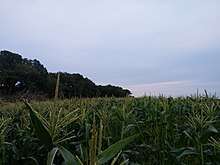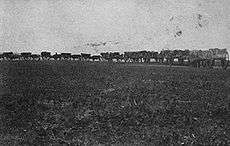Economy of Manitoba
 Corn field in southern Manitoba | |
| Statistics | |
|---|---|
| GDP | C$67.863 billion (nominal; 2016)[1] |
GDP growth | 2.22% (2016)[1] |
GDP per capita | C$51,484.89[1][2] |
| 1.2% (2015)[3] | |
| External | |
| Exports | C$13.7 billion (2015) [4] |
| Imports | C$20.9 billion (2015) [5] |
|
All values, unless otherwise stated, are in US dollars. | |
The economy of Manitoba is a market economy based largely on natural resources. Agriculture, mostly concentrated in the fertile southern and western parts of the province, is vital to the province's economy. Other major industries are transportation, manufacturing, mining, forestry, energy, and tourism.
The province's economic history dates to before European contact, and was originally based on a First Nations trading network. European traders arrived in the 17th century and organized a trans-Atlantic fur trade. Agricultural settlers arrived in the early 19th century, and Manitoba became a province of Canada in 1870.
Economic history

Manitoba's early economy depended on mobility and living off the land. Aboriginal Nations (Cree, Ojibwa, Dene, Sioux and Assiniboine) followed herds of bison and congregated to trade among themselves at key meeting places throughout the province. After the arrival of the first European traders in the 17th century, the economy centred on the trade of beaver pelts and other furs.[6] Diversification of the economy came when Lord Selkirk brought the first agricultural settlers in 1811,[7] though the triumph of the Hudson's Bay Company (HBC) over its competitors ensured the primacy of the fur trade over widespread agricultural colonization.[6]
HBC control of Rupert's Land ended in 1868; when Manitoba became a province in 1870, all land became the property of the federal government, with homesteads granted to settlers for farming.[6] Transcontinental railways were constructed to simplify trade. Manitoba's economy depended mainly on farming, which persisted until drought and the Great Depression led to further diversification.[8]
Modern economy
| Part of a series on the |
| Economy of Canada |
|---|
| Economic history of Canada |
| Sectors |
|
| Economy by province |
| Economy by city |
Manitoba has a moderately strong economy based largely on natural resources. Its Gross Domestic Product was C$67.863 billion in 2016.[1] The province's economy grew 2.22% from 2015 to 2016.[1] The average individual income in Manitoba in 2016 was C$51,484.89[1][2] As of October 2017, Manitoba's unemployment rate was 5.2%.[9]
Manitoba's economy relies heavily on agriculture, tourism, energy, oil, mining, and forestry. Agriculture is vital and is found mostly in the southern half of the province, although grain farming occurs as far north as The Pas. Around 12% of Canadian farmland is located in Manitoba.[10] The most common agricultural activity is cattle farming (34.6%), followed by assorted grains (19.0%) and oilseed (7.9%).[11] Manitoba is the nation's largest producer of sunflower seed and dry beans,[12] and one of the leading sources of potatoes. Portage la Prairie is a major potato processing center, and is home to the McCain Foods and Simplot plants, which provide French fries for McDonald's, Wendy's, and other commercial chains.[13] Can-Oat Milling, one of the largest oat mills in the world, also has a plant in the municipality.[14]
Manitoba's largest employers are government and government-funded institutions, including crown corporations and services like hospitals and universities. Major private-sector employers are The Great-West Life Assurance Company, Cargill Ltd., and James Richardson and Sons Ltd.[15] Manitoba also has large manufacturing and tourism sectors. Churchill's Arctic wildlife is a major tourist attraction; the town is a world capital for polar bear and beluga whale watchers.[16] Manitoba is the only province with an Arctic deep-water seaport, which links to the shortest shipping route between North America, Europe and Asia.[17]
Key Industries
In 2015, Manitoba's economy had the following relative weighting by industry, as a percentage value of GDP [18]
- 11% Trade
- 10% Manufacturing
- 10% Finance, Insurance & Real Estate
- 9% Construction
- 8% Government
- 6% Transportation & Warehousing
- 5% Mining & Other Primary
- 4% Information, Culture, Arts & Entertainment
- 3% Agriculture
- 3% Utilities
- 31% Other Services
References
- 1 2 3 4 5 6 Statistics Canada. Statistics Canada. Table 36-10-0222-01 Gross domestic product, expenditure-based, provincial and territorial, annual (x 1,000,000) [Retrieved 2018-09-28].
- 1 2 "Population estimates on July 1st, by age and sex". Retrieved 2018-09-28.
- ↑ "Economy: Inflation, Manitoba vs. Canada". Retrieved 2018-09-28.
- ↑ "Economy: Manitoba Foreign Exports". Retrieved 2018-09-28.
- ↑ "Economy: Manitoba Imports". Retrieved 2018-09-28.
- 1 2 3 Friesen, Gerald. The Canadian prairies: a history. Toronto: University of Toronto Press; 1987. ISBN 0-8020-6648-8. p. 22–47, 66, 183–184.
- ↑ Morton, William L. Lord Selkirk Settlers. Manitoba Pageant. April 1962;7(3):n.p.
- ↑ Easterbrook, William Thomas; Aitken, Hugh GJ. Canadian economic history. Toronto: University of Toronto Press; 1988 [Retrieved 2009-11-07]. p. 493–494.
- ↑ "Unemployment rate by province, October 2017". Statistics Canada. 2017-11-03. Retrieved 2018-09-28.
- ↑ Statistics Canada. Total farm area, land tenure and land in crops, by province (Census of Agriculture, 1986 to 2006) (Manitoba) [archived 2011-01-15; Retrieved 2009-10-28].
- ↑ Statistics Canada. Statcan Summary Table of Wheats and Grains by Province [archived 2011-01-15; Retrieved 2007-08-07].
- ↑ University of Manitoba. A Century of Agriculture [archived 2008-09-10; Retrieved 2009-10-28].
- ↑ New Simplot french fry plant in Canada expected to come on line later this year. Quick Frozen Foods International. 2002-07-01;2(3):3.
- ↑ A Case Study of the Canadian Oat Market. Alberta Agriculture, Food and Rural Development. November 2005 [Retrieved 2010-01-29]:74.
- ↑ Top 100 Companies Survey 2000. Manitoba Business Magazine. July 2000;26.
- ↑ Shackley, Myra L. Wildlife tourism. International Thomson Business Press; 1996. ISBN 0-415-11539-6. p. xviii.
- ↑ Hudson Bay Port Company. Port of Churchill [Retrieved 2009-10-28].
- ↑ "Economy: Manitoba GDP by Industry (Basic Prices)". Retrieved 2018-09-28.